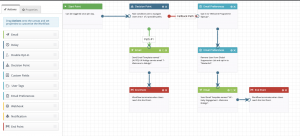— July 27, 2017
Coworking, which in short is the usage of large building areas to provide room to a large number of businesses, regardless of their niche, has become the trend to follow during the last couple of years. We may ask ourselves why is this happening instead of companies acquiring their own office area or settling down at unused home space. Well, the answer to this question can be analysed from two points of view:
1) The rates to pay for acquiring an individual office: For most top cities worldwide, but with a particular emphasis in places like London, New York or Berlin, the rental fees to pay for an office have risen to the point of becoming a crucial budget factor for most emerging companies. Instead, shared office space allows rising companies to share the rental bills to pay, increasing the budget for locating your headquarters at trendy neighbourhoods with superb infrastructure connections to other points of interest in the city.
2) The “climate” generated at coworking spaces: One may say that 9-to-5 office work is undoubtedly outdated, but what happens if we add to that classic formula the possibility of sharing the same building with someone who works in an industry entirely different as yours? For your workers, that might be a good motivational factor as they aren’t just doing their job but also learning from others – but in case everything else fails, they can also be inspired by other companies’ drive to meet their goals.
![Essential Aspects to Consider for Coworking Spaces [Infographic] Essential Aspects to Consider for Coworking Spaces [Infographic]](https://www.onlinesalesguidetip.com/wp-content/uploads/2017/08/Essential-Aspects-to-Consider-for-Coworking-Spaces-1.jpeg)
Despite how promising this can look when talked lightly, having an efficient coworking space is a challenge to consider, as lack of productivity is the #1 enemy of shared office spaces. Is there something we can do to improve our chances of success in this adventure? Stay tuned to the following tips for maximizing productivity in coworking spaces.
1.- Become familiarized with your company’s needs regarding office space
This first point may seem a little too vague, however, is the first step towards success. How can we be certain of what we need if we don’t even think for a second the essential aspects involved in not just having the perfect climate to work, but also on providing a motivational space for your workers.
Set a meeting with your team members at the moment, you decide to consider co-working as your answer to office space demands. Then, list down all the aspects that make a perfect work climate – examples of these factors can be: natural lighting, soundproof protection to avoid disturbances from outside (and especially from other offices), proximity to public offices, accessibility, and so on. Then, put particular emphasis on what your workers decide to have to enjoy their spare time – perhaps a large area with gaming consoles and comfortable places to eat might be a good idea if you give 1 hour to rest to your employees or even a place to nap if they feel the need to do so. What about a nursery area for those new mums who can’t consider babysitting as an option due budget? Those are the factors that make a difference when creating an ideal workplace.
2.- Acknowledge what your neighbors are going to be like
If you decide to take the coworking way for your company, then you must be aware of the activities of your future building partners. What’s the point of renting an office space at a building where noisy industrial activities take place if your company requires absolute quiet to perform its operations?
Take a tour around the building, the neighborhood and also consider the people who acquire the product/services of your office neighbors. Those are important aspects to consider that can shape the outcome of your coworking experience.
3.- Put a stopper to procrastination
One acknowledged disadvantage of shared office spaces relies on the possibility of distracted workers who seek the chance to “have a chat” with employees of other companies hosted under the same building. Regardless of how strict your rules can be on this behalf, this is something bound to happen as it proves to be part of the natural human curiosity, to be aware of what’s going on nearby.
![Essential Aspects to Consider for Coworking Spaces [Infographic] Essential Aspects to Consider for Coworking Spaces [Infographic]](https://www.onlinesalesguidetip.com/wp-content/uploads/2017/08/Essential-Aspects-to-Consider-for-Coworking-Spaces.jpeg)
Photo courtesy of Pexels: iPrice Group
Why not encourage such exchanges by allowing your workers a 20-min break to talk with their office neighbors instead of forbidding it? By doing so, you will become the “cool boss” instead of “the ogre” who discourages social interaction.
In case you are worried about giving too many liberties on this behalf, you can always set sound alarms to let your workers know when the time off is over, and if you invest resources in social media blockers, then you are also reducing the chances of wasted time in non-productive activities. More information on this behalf can be seen on this infographic courtesy of Ooma.
![Essential Aspects to Consider for Coworking Spaces [Infographic] Essential Aspects to Consider for Coworking Spaces [Infographic]](https://www.onlinesalesguidetip.com/wp-content/uploads/2017/08/Essential-Aspects-to-Consider-for-Coworking-Spaces-Infographic.png)
4.- Avoid visual distractions
How much time do we lose a day by just looking at what’s going on nearby? We would be surprised if we sum those minutes in a weekly basis, and the reason for that is strictly linked to the visual elements that might catch our interest.
For office spaces, one of the worst working setups is to be surrounded by views of crowded city areas – hence the reason why large companies decide to place their headquarters right next to breath-taking natural landscapes instead of urbanscapes. A traffic accident, a parade, a strike or many other aspects that involve the common events of a city are potential distractors to your workers since they will be alerted not just by the views but also by noise.
Coworking is one of the most interesting consequences of new working trends, but it’s entirely up to us to shape the outcome of this experience into a comfortable working environment.
Digital & Social Articles on Business 2 Community
(64)
Report Post








